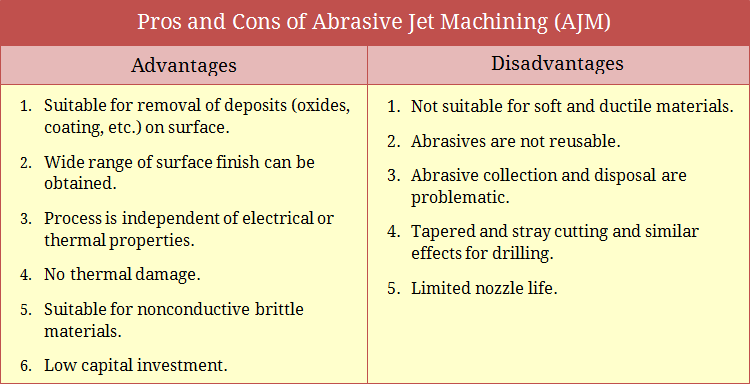In abrasive jet machining, a high velocity jet of abrasives is made to strike the work surface for removal of material by impact erosion. This process is favorable for removing various deposits and coatings on metallic and ceramic surfaces. It can also be applied for cutting and drilling operations. However, the process is not suitable for every type of materials. It is preferred for hard substrates (work materials). Various advantages and disadvantages of abrasive jet machining (AJM) are elaborated in the successive sections. A list of pros and cons of AJM is also depicted below.

Advantages of abrasive jet machining
Suitable for removal of deposits on surface—No conventional machining can completely remove various surface deposits (such as dirt, color, coating, oxide, etc.) without cutting the basic substrate. Abrasive jet machining (AJM) can be advantageously utilized for such purpose.
- Read more: Applications of AJM process.
Wide range of surface finish can be obtained—Surface roughness of 0.1 – 1.5 micron is achievable in AJM using various sizes of abrasives. Larger grit size provides high surface roughness but high material removal rate (MRR).
High degree of flexibility—Since AJM uses flexible hose for carrying gas-abrasive mixture, so the jet can be carried in difficult to machine areas.
Process is independent of electrical or thermal properties—Electrical or thermal conductivity of work material does not influence the abrasive jet machining capability.
No thermal damage of workpiece—Unlike conventional machining or thermal energy based non-traditional machining processes, AJM produce no palpable heat during machining. This protects the workpiece from thermal damage. It also facilitates machining of heat sensitive materials without having much problem.
Suitable for nonconductive brittle materials—Machining such materials is challenging task. Because of its non-conductive and brittle nature, neither conventional machining nor few electrical energy based NTM processes (like ECM, EDM, and EBM) can be applied favorably. Abrasive jet machining is, in fact, preferred for machining such materials.
Low capital investment—Cost of AJM setup is comparatively low as compared to set-up for other NTM processes.
Disadvantages of abrasive jet machining
Not suitable for soft and ductile materials—If AJM is used for machining such materials, then hard abrasive grits tend to remain embedded on the machined surface and this hampers accuracy and surface quality.
Abrasives are not reusable—After the first impact, abrasives loose its shape and sharp edges. So reuse of abrasive grits may result in lower material removal rate and unpredicted machining accuracy. Need for fresh abrasives increases machining cost.
Abrasive collection and disposal are problematic—Tiny grains of abrasive are injurious to health and must not be allowed to mix with atmosphere after machining. Thus a close machining chamber with proper ventilation system is mandatory. Disposal of used abrasives (mixed with metal particles) is also problematic, especially when available in large quantities.
Inaccurate cutting and drilling—AJM is good for removal of deposits on surface (such as coating, oxides, etc.). However, if the same is applied for cutting various shapes or drilling holes, the quality of cut may not be good because of jet flaring. Machined surfaces are usually tapered and most of the time it exceeds tolerance limit.
Limited nozzle life—AJM nozzle can be satisfactorily used for about 20 – 30 hours (for common tungsten carbide nozzle; sapphire nozzles have much higher life time). Such a short life time needs frequent replacement of nozzles (increases idle time) and all these lead to substantial increase in overall machining cost.
References
- Book: Unconventional Machining Processes by T. Jagadeesha (I. K. International Publishing House Pvt. Ltd.).
- Book: Advanced Machining Processes by V. K. Jain (Allied Publishers Private Limited).
- Book: Nonconventional Machining by P. K. Mishra (Narosa Publishing House).